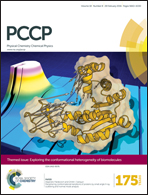A theoretical study on charge transport of dithiolene nickel complexes†
Abstract
Organic semiconducting materials play an important role in the fabrication of high performance organic electronic devices. In the present work, we theoretically designed a series of organic semiconductors based on nickel complexes. Their characteristics of charge transport were investigated using DFT computational approaches. Based on the computed results, all compounds designed are found to be excellent candidates for ambipolar organic semiconductors with low reorganization energies for both holes and electrons. The (I–V) characteristics and transmission spectra of materials show that the replacement of benzene rings by thiophene rings results in an increase of their HOMO and LUMO energy levels. HOMOs of compounds containing thiophene end-groups are likely dominant for their conductance, while LUMOs of compounds containing benzene end-groups mainly affect their conductance. The electron distribution in these frontier MOs is identified as the main reason which makes the conductance of the compounds in the first series higher than those in the later series.


 Please wait while we load your content...
Please wait while we load your content...